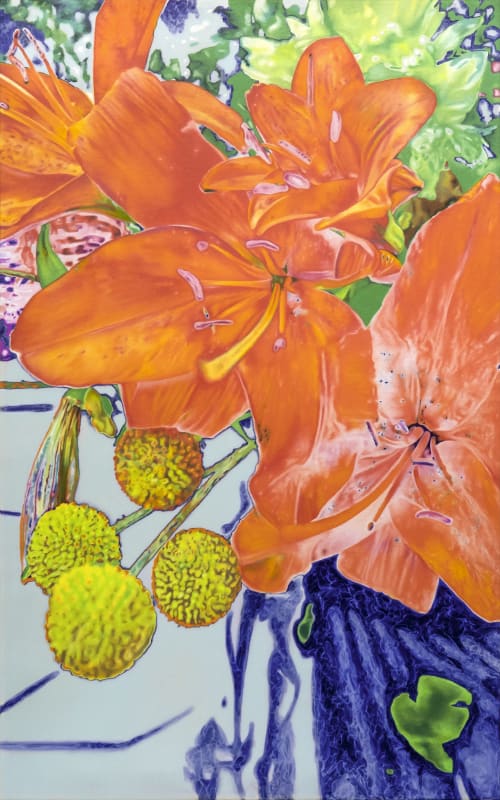Private View: Tuesday 10th January 2023, 6:30-9pm Berlin
Sun-drenched canvases filled with giant, brightly colored blooms and tangled stems evoke a lush, jungle-like space. These are not, however, visions of Eden – or at least not in any traditional kind of way. Martine Poppe’s overblown landscapes are warped and glitching with pixelated surfaces and strange, shimmering forms. Peering at the Edge of Daydreams, the artist’s sixth solo exhibition with Kristin Hjellegjerde Gallery, marries Poppe’s ongoing interest in climate issues and ecofeminism with the tropes of bubblegum minimalism – vivid colors, flowers, sunshine – that are designed to create a sense of joy and ease. The result are quietly complex works that celebrate play and creativity as powerful tools for altering the ways in which we see and engage with the world around us.
The exhibition’s title, borrowed from a poem by the Irish writer and ecofeminist Rosemarie Rowley, makes reference to a slip out of reality, a wavering, in-between space. When we daydream, our imagination lifts us out of reality and though this is a form of escapism, it can also be a revelatory experience. As Poppe notes, ‘you end up being honest with yourself in a way that you’re not ordinarily.’ For her, the process of making these latest paintings felt like a necessary daydream, a retreat into a happier, brighter place that embraces experimentation and the simple beauty of nature. ‘If there were ever a moment for defiant joyfulness, it’s now,’ she says, but at the same time, the paintings, in their determined cheerfulness, point at the artifice of their own making. On a closer look, the huge, peach-colored petals of lilies are speckled with green, the soft, ruffled centres of hydrangeas are yellowing, and the luminescent bulbs of seed heads appear sickly and bacterial.
This shifting sense of perspective is the result of both process and materiality. With this latest series, Poppe heavily manipulated her photographs to not just enhance the light and warp the colors, but to also reduce areas of shadow. The remaining areas of darkness appear as isolated pixels when printed at a large-scale and are further intensified in the transference from digital image to painted surface – Poppe covers the printed image with a translucent type of sail cloth which she paints directly onto in quick, textural gestures that evoke the distorted effect while also recording her physical movements. As a result, the areas of darkness come to symbolise not just the transience of nature, but also our hand in its demise. As Poppe notes, her ‘accidental’ pollution of the perfect image is, to a certain extent, ‘a tongue-in-cheek comment on the willful blindness and forced cheerfulness in current politics concerning environmental change.’ However, the purpose of these paintings is not to pass judgment or illicit feelings of guilt – instead they seek to demonstrate the subversive power of positivity.
Poppe first came across the term ‘bubblegum minimalism’ in relation to a particular style of pop music and literature, but what she finds most interesting is how the avoidance of negativity has the effect not so much of removing that feeling as creating a void. In other words, we become hyper aware of the unreality of the situation, of the performance, or in Poppe’s case, the image. In turn, we are able to reflect more clearly on what’s lacking. ‘My art history teachers would say there was something similar going on in the joie de vivre art of the 1910s and 20s, when movements such as Art Deco and Art Nouveau had a lot of influence,’ says Poppe. ‘However, they would also criticize those movements for being blind to what was coming whereas I believe that art responds to the needs of the time in which it is made.’
Within the context of global concerns around the environment, political upheaval, human rights issues and financial crashes, Poppe’s radiant paintings offer not just a welcome sense of relief, but also hope. While art might be a ‘daydream’, it is also a way of inspiring real-life action and change.


